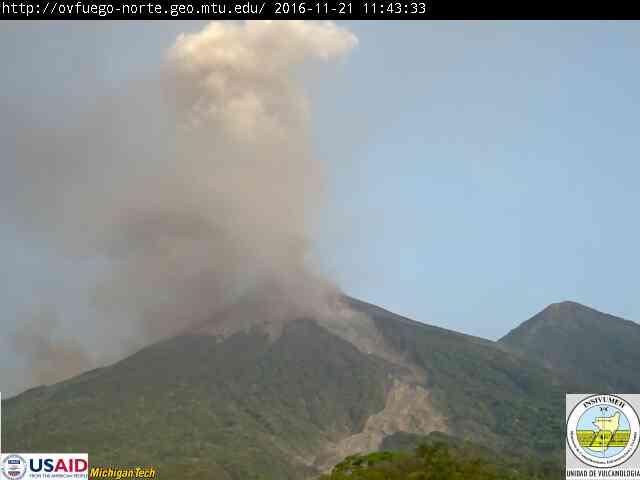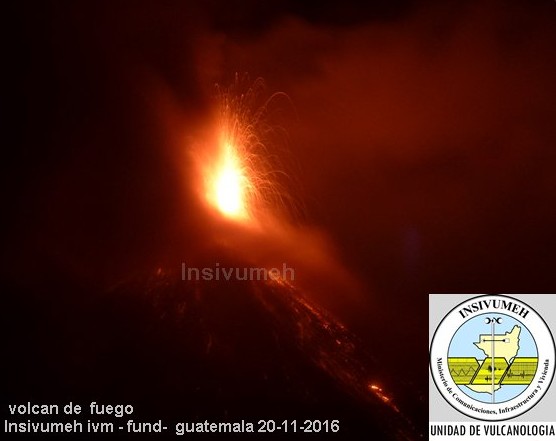Eruption at Fuego volcano intensifies, Guatemala

The explosive activity at Guatemalan Fuego volcano has intensified since November 19, 2016 and has generated at least one 300 m (984 feet) high lava fountain, feeding three new lava flows. This is the 15th paroxysm at the volcano this year.
The Washington VAAC reports today that satellite imagery suggests ongoing volcanic ash emissions and extremely large and bright hotspot in IR imagery. INSIVUMEH suggests an uptick in activity supports this.
At 08:45 UTC today, the center reported ongoing volcanic emissions with ash extending 46.3 km (28.7 miles) to the south and roughly 167 km (103.6 miles) to the west of the summit.
The lava flows are currently reaching 1 km (0.62 miles), 2 km (1.24 miles) and approximately 2.5 km (1.55 miles).
Moderate explosions are reported as well as several strong, accompanied by a column of ash that reaches an approximate height of 4.5 – 5 km (up to 16 404 feet) above sea level.

Image courtesy INSIVUMEH
Shock waves and constant rumbling have been reported, INSIVUMEH said in a special bulletin issued 03:45 UTC today.
Ashfall was reported in Morelia, Santa Sofía and Panimaché I and II.
The eruption continues and there is a possibility of pyroclastic flows, INSIVUMEH said, and warned people not to stay inside or in the vicinity of the main ravines.

Image courtesy INSIVUMEH
Geological summary
Volcán Fuego, one of Central America's most active volcanoes, is one of three large stratovolcanoes overlooking Guatemala's former capital, Antigua. The scarp of an older edifice, Meseta, lies between 3 763 m (12 345.8 feet high Fuego and its twin volcano to the north, Acatenango. Construction of Meseta dates back to about 230 000 years and continued until the late Pleistocene or early Holocene. Collapse of Meseta may have produced the massive Escuintla debris-avalanche deposit, which extends about 50 km (31 miles) onto the Pacific coastal plain.
Growth of the modern Fuego volcano followed, continuing the southward migration of volcanism that began at Acatenango. In contrast to the mostly andesitic Acatenango, eruptions at Fuego have become more mafic with time, and most historical activity has produced basaltic rocks. Frequent vigorous historical eruptions have been recorded since the onset of the Spanish era in 1524, and have produced major ashfalls, along with occasional pyroclastic flows and lava flows. (GVP)
Featured image: Fuego erupting on November 20, 2016. Credit: INSIVUMEH

Commenting rules and guidelines
We value the thoughts and opinions of our readers and welcome healthy discussions on our website. In order to maintain a respectful and positive community, we ask that all commenters follow these rules.